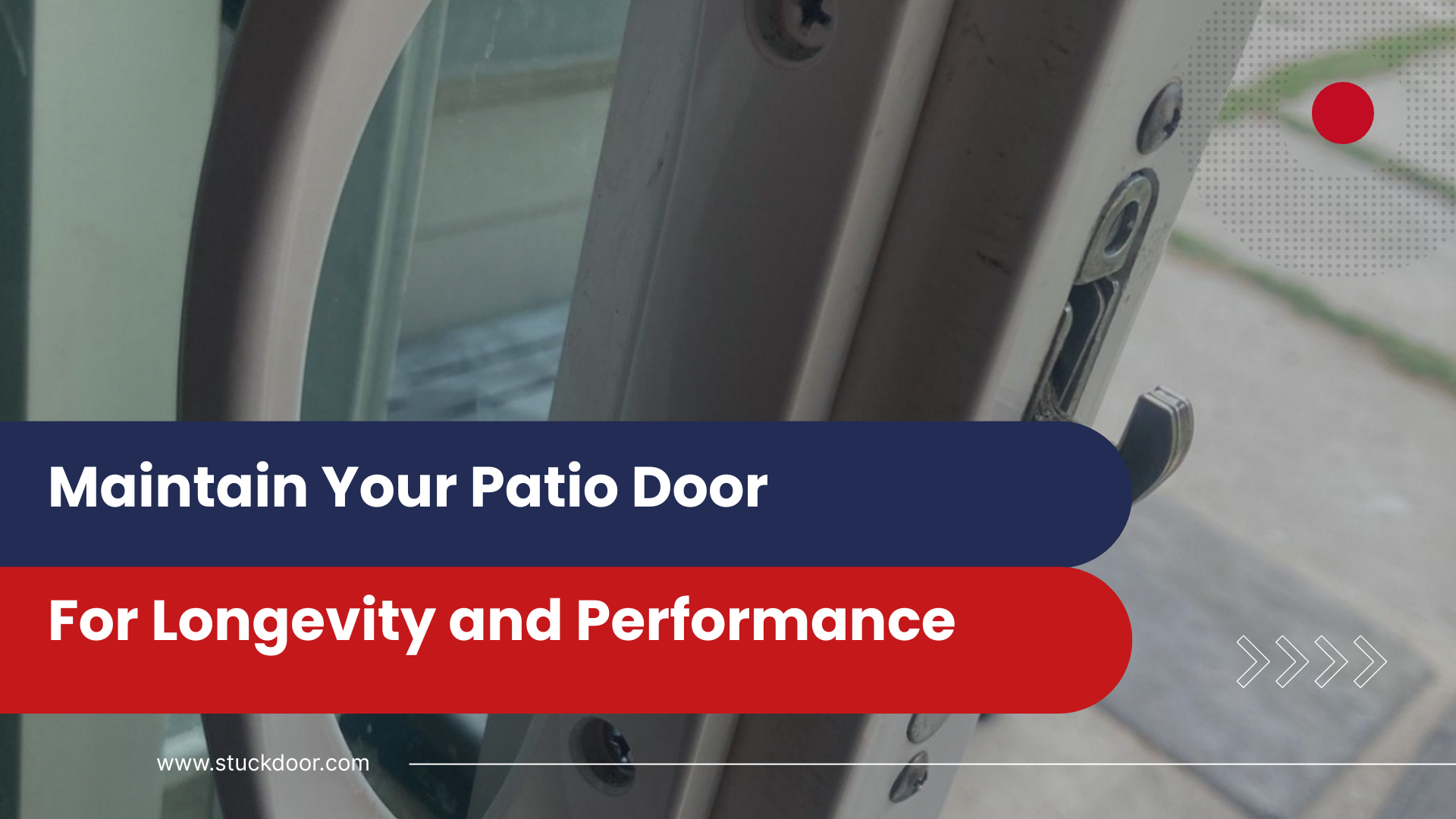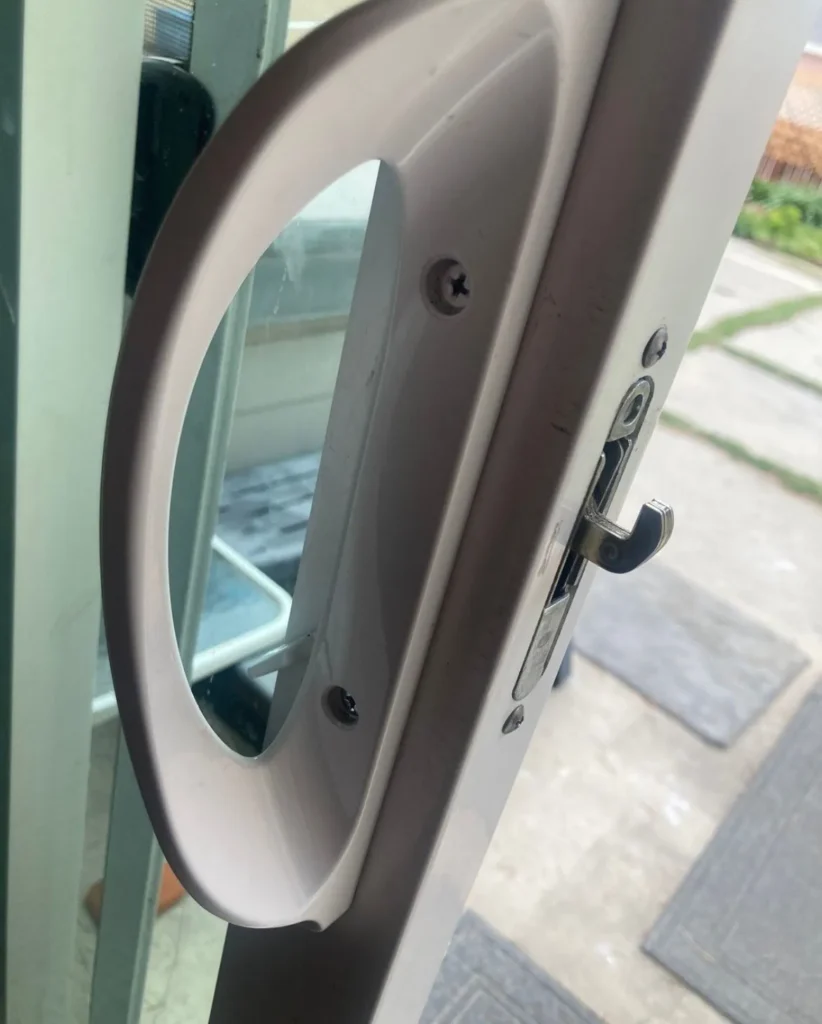
Your patio door is working hard right now. While you’re reading this, it’s blocking Central Florida’s humidity, filtering UV rays, insulating your home, and standing ready to provide instant access to your outdoor space. It opens and closes hundreds of times per year, endures temperature swings, and battles windblown debris.
Yet most homeowners don’t think about patio door maintenance until something goes wrong. That squeaky sound you’ve been ignoring? That tiny gap letting in drafts? That door that’s getting harder to slide? These are early warning signs that your door is asking for help.
The good news: properly maintained patio doors can last approximately 20 years or more. The even better news: the maintenance required to reach that lifespan is surprisingly simple. We’re talking minutes per month, not hours per week.
Let’s make sure your patio door reaches its full potential.

Alt text: “Well-maintained sliding patio door with clean tracks and clear glass showing proper maintenance results”
Before we get into the “how,” let’s talk about the “why.” Understanding what maintenance prevents makes you more likely to actually do it.
Short-term consequences (1-2 years):
Medium-term consequences (3-5 years):
Long-term consequences (5-10 years):
The math is simple: 15 minutes of monthly maintenance prevents thousands in repairs. That’s a pretty good return on investment.
[Image suggestion: Timeline infographic showing well-maintained vs neglected patio door lifespan]
Alt text: “Comparison timeline showing lifespan of well-maintained patio door versus neglected door with maintenance impact”
This is your foundation. Fifteen minutes once a month keeps your patio door in excellent condition.
Your patio door tracks are exposed to seasonal temperature extremes and blown-in debris, so cleaning them monthly is essential.
What you’ll need:
The process:
Step 1: Slide the door open completely to access both tracks
Step 2: Vacuum all loose debris from both the top and bottom tracks. Don’t skip the top track—it collects dust too.
Step 3: Mix warm water with a few drops of dish soap
Step 4: Dip your brush in the soapy water and scrub the tracks thoroughly, working from one end to the other
Step 5: Use the butter knife wrapped in cloth to get into tight corners and remove compacted dirt
Step 6: Wipe everything down with a clean, damp microfiber cloth
Step 7: Dry completely before closing the door
Pro tip: If you have pets, you’ll probably need to clean weekly. Pet hair is the nemesis of smooth-sliding patio doors.
Use a non-abrasive cleaner to remove fingerprints, dirt, and smudges, and watch for any fogging or condensation between double panes, which could indicate failing seals.
For interior glass:
For exterior glass:
Important: If you notice fogging or condensation between glass panes, your seal has failed. This requires professional attention—it can’t be DIY fixed.
This simple step prevents the majority of patio door problems.
What you’ll need:
The process:
Step 1: Slide the door to halfway open
Step 2: Locate the rollers at the bottom of the door (you may need to tip the door slightly or use a flashlight)
Step 3: Spray silicone lubricant directly onto each roller—about 2-3 seconds per roller
Step 4: Slide the door back and forth several times to work in the lubricant
Step 5: Wipe up any overspray with paper towels
Why silicone spray? Unlike oil, it doesn’t attract dirt and debris. Oil-based lubricants create sticky buildup that actually makes problems worse over time.
[Image suggestion: Close-up of hand applying silicone spray to patio door rollers]
Alt text: “Applying silicone spray lubricant to patio door rollers for smooth operation and preventive maintenance”
Every three months, go deeper with these additional tasks.
Weatherstripping is what keeps air, water, and bugs out. It needs attention.
What to check:
Cleaning weatherstripping:
When to replace: If you see cracks, tears, or the seal no longer springs back when pressed, it’s time for replacement. Weatherstripping kits cost $20-$50 and are DIY-friendly.
Keep the threshold clean and free of dirt and debris to ensure a proper seal.
The frame:
The threshold:
Central Florida specific: Our sandy soil gets tracked everywhere. Pay extra attention to threshold cleaning if you have kids or pets coming in from the yard.
All the small parts need attention too.
What to check:
Maintenance:
Even with good maintenance, doors can settle over time.
Signs your door needs adjustment:
Quick adjustment test:
If adjustment is needed, refer to our previous guides or call a professional. Small adjustments now prevent big problems later.
[Image suggestion: Checklist being marked off showing quarterly maintenance tasks]
Alt text: “Homeowner checking off quarterly patio door maintenance tasks including weatherstripping and hardware inspection”
Once per year, give your patio door comprehensive attention.
Walk through your door like a building inspector would:
Glass inspection:
Frame inspection:
Track inspection:
Roller inspection:
This goes beyond your monthly routine.
Track deep clean:
Frame restoration:
Every 3-5 years, consider having a professional inspect your patio door, especially if it’s more than 10 years old. We can spot early problems you might miss and make adjustments that extend your door’s life significantly.
[Image suggestion: Professional conducting annual patio door inspection with checklist]
Alt text: “Licensed professional conducting comprehensive annual patio door inspection with maintenance checklist”
Our climate requires some special attention.
Before hurricane season arrives:
Structural check:
Storm preparation:
Central Florida summers are brutal on patio doors.
Moisture prevention:
Heat expansion management:
Even Florida winters stress your door.
Energy efficiency check:
After severe weather, always inspect your patio door:
After 14 years, we’ve seen these mistakes repeatedly. Don’t make them.
Mistake #1: Using harsh chemicals
Abrasive cleaners damage seals, glass coatings, and frame finishes. Stick with mild soap and water for almost everything.
Mistake #2: Over-lubricating
More isn’t better. Excess lubricant attracts dirt. A light coating is all you need.
Mistake #3: Ignoring small problems
That tiny squeak or slight sticking? It’s a warning sign. Address it now before it becomes expensive.
Mistake #4: Forcing anything
If something doesn’t move smoothly, forcing it causes damage. Figure out why it’s stuck instead.
Mistake #5: Using a pressure washer
High pressure can force water past seals and damage components. Hand cleaning is safer.
Mistake #6: Forgetting the top track
Everyone cleans the bottom track. The top track collects dust too and affects operation.
[Image suggestion: Side-by-side comparison showing correct vs incorrect maintenance techniques]
Alt text: “Correct and incorrect patio door maintenance techniques showing proper cleaning and lubrication methods”
Maintenance can prevent most problems, but sometimes professional help is needed.
ð§ Door has fallen off the track
ð§ Rollers are visibly broken or won’t spin
ð§ Glass is cracked or seal has failed
ð§ Frame is significantly warped or damaged
ð§ Door won’t lock properly despite maintenance
ð§ Water is leaking around the door
ð§ You see mold or mildew around the frame
ð§ Mysterious drafts you can’t locate
ð§ Door has shifted and won’t adjust
ð§ Major structural concerns
These issues are beyond DIY maintenance and need expert diagnosis and repair.
Print this out and stick it on your fridge:
Monthly (15 minutes):
Quarterly (30 minutes):
Annually (1-2 hours):
Seasonally:
[Image suggestion: Visual calendar showing maintenance schedule throughout the year]
Alt text: “Annual patio door maintenance calendar showing monthly, quarterly, and seasonal maintenance tasks schedule”
Let’s do some quick math on maintenance value:
Annual maintenance cost:
Total annual investment: $80 + 4 hours
What it prevents:
Over a 20-year period, basic maintenance saves you potentially $10,000 or more. That’s not counting the convenience of a smoothly operating door and the peace of mind knowing your home is properly sealed.
You don’t need to wait for the first of the month or a perfect Saturday morning. Start right now with a quick track cleaning. It’ll take five minutes and you’ll immediately feel the difference in how your door operates.
Set a phone reminder for monthly maintenance. Make it a habit like checking smoke detectors or changing air filters. Your patio door will reward you with decades of reliable service.
Need professional help getting your patio door back in top shape? Contact Posada Remodeling & Design for a comprehensive patio door inspection and tune-up. We serve Central Florida with 14 years of expertise in door maintenance, repair, and replacement. Let us help you maximize your door’s lifespan and performance.
Sometimes the best maintenance decision is bringing in an expert to assess what you’re working with and show you exactly what your specific door needs.
Stuck Door helps fix and install sliding doors in Winter Garden, Clermont, Windermere, and across Central Florida. Our friendly expert technicians have years of experience making sure homes and businesses have reliable doors that work perfectly.
Windermere • Doctor Phillips • Lake Nona • Winter Garden • Clermont • Minneola • Groveland • Ocoee • Apopka • Winter Park • Maitland • Kissimmee • Horizon West • Altamonte Springs
Sliding glass door experts, built for Florida homes—call us today.